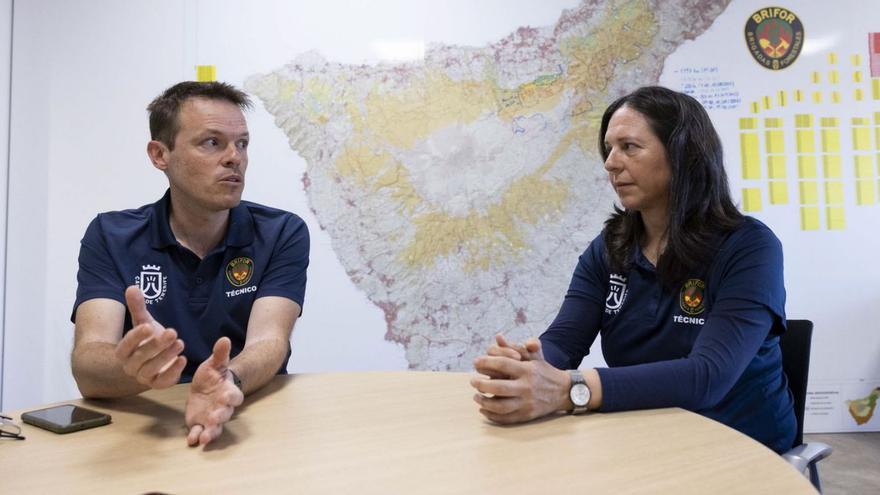
Tenerife undertakes mountain guardianship in fear of drought in a task that goes beyond mere emergency with the major forest fire from last August in the background. The island expands the firefighting Brifor Operation to five months, from June 3 – Monday – to September 3, facing a summer that is expected to be on high alert due to soaring temperatures. “If there are three to four strong heatwaves, we will have a difficult period,” foresees Pedro Tito Martínez, head of the Forest Management technical service at the Cabildo. Along with his colleague, forestry engineer Adela Conde, they reveal the challenges they face during the most critical period of the year.
The special firefighting unit will protect the mountains 24 hours a day with surveillance, care, and training. Its staff, around 300 individuals, will encounter two major concerns: persistent drought – including the declaration of a water emergency – and the disconnection of citizens from the rural world. Martinez and Conde unveil the challenges with the aftermath of the major 2023 wildfire, which burnt more than 12,000 hectares in twelve municipalities.
“If we assess how summer is on June 1st every year, we are facing one of the worst June 1sts: the amount of water in the forested area is lower and the chances of a fire occurring and spreading intensively are higher,” says Pedro Martínez.
Temperature and humidity. The specialist refers to how temperature and humidity affect the state of the fuel because if it accumulates water or is dry, it influences the subsequent behaviour of the fire and its energy. He is clear: “If there are three to four strong heatwaves, we will have a challenging summer.” What worries this technical personnel from the Tenerife Cabildo the most is the drought that the island is facing, a situation that could lead, for example, to impacts on the self-protection of the laurel forests, as in 2012 with the fire that affected the Garajonay National Park (La Gomera).
“After a significant period of drought, many of these masses do not accumulate water, and their behaviour in the event of a fire would be similar to that of a pine forest,” they point out. If the fire approached these tree species, it would not spend “as much energy” evaporating their water and would ignite with greater intensity.
Treatments. Among the treatments they carry out in the forest to address emergencies, they highlight three: clearing the Canary pine forest, removing the Californian species imported in the mid-20th century – the Radiata pine – and, finally, recovering masses of the so-called laurel forests. Engineer Adela Conde explains that the latter is a 20-year task that results in the forest having “less density.” She emphasizes and clarifies that “the idea is to try to make everything resemble more that natural mass that would exist without human intervention.”
Disconnection from the rural. Regarding the major 2023 fire, they recall the citizen collaboration in critical moments but lament the social “disconnection” that exists with the mountain, a scenario that, in part, encourages “noises and opinions” about the work they carry out throughout the year. Martinez points out that it is such a significant disconnection that certain information provided by the administration is not accepted, a situation that, in his opinion, occurs because official messages are directly perceived as “deception.” He gives an example: “You ask on the street if you can collect pine needles, and they will tell you it has been prohibited. That is not the case. Municipalities grant annual authorisations to residents.” This disconnection to the mountain also influences the progressive abandonment of rural activity, a trend that reduces cultivated areas in interface zones and opportunities to halt the spread of fire. In addition, forest management, according to the expert, is progressing at a different pace than society, due to economic factors and nature itself. Therefore, its changes can be seen over 40 years and even reach 80. Martínez adds that Tenerife has “a certain accumulated delay” in the treatment of its forest masses, reforested with a large amount of biomass that can burn and should have received treatments over 50 years.
















